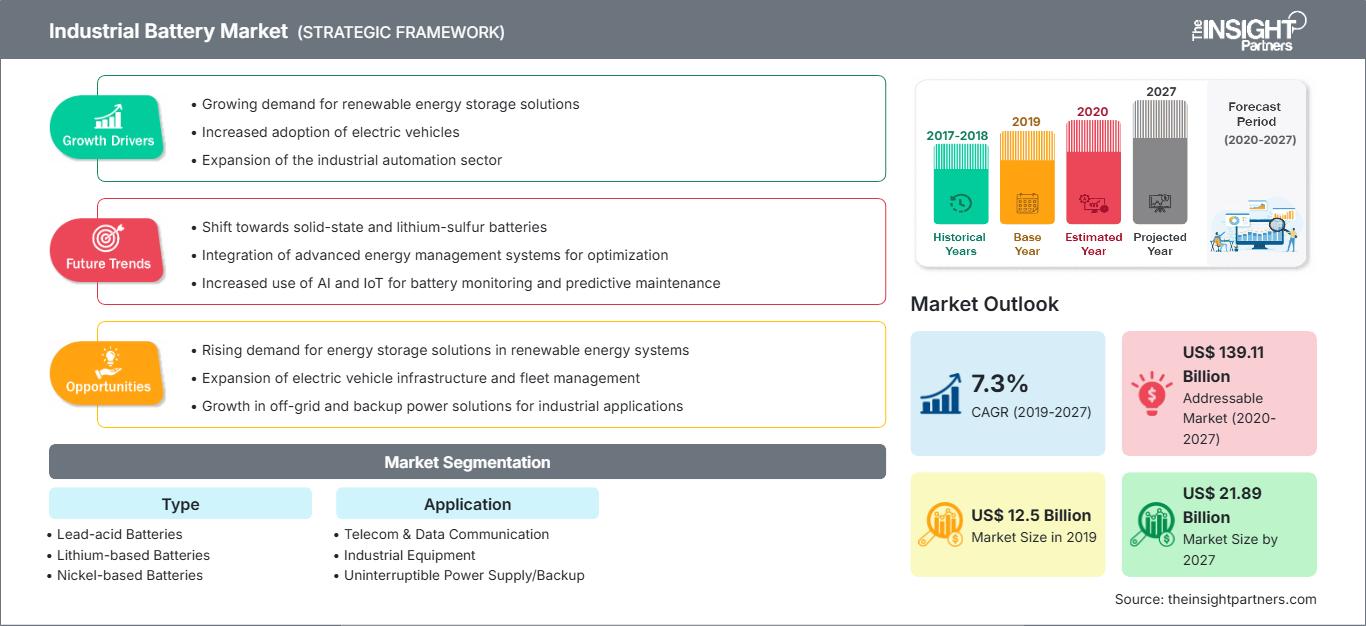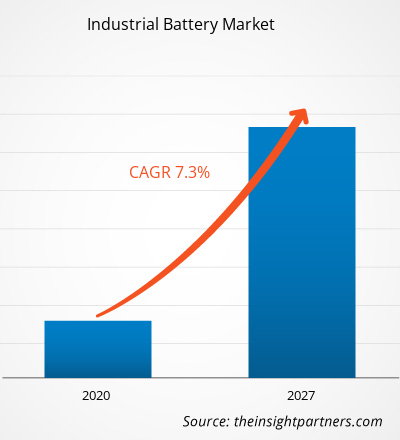El mercado de baterías industriales se valoró en US$ 12.501,9 millones en 2019 y se espera que crezca a una CAGR del 7,3% entre 2020 y 2027 para alcanzar los US$ 21.893,5 millones en 2027.
Las baterías industriales son baterías especialmente diseñadas que pueden operar bajo duras temperaturas industriales, como temperaturas extremas, mayor vibración y uso intensivo. Las baterías industriales tienen un mayor rendimiento y están diseñadas para ser más potentes. En el escenario actual del mercado, las empresas están trabajando rigurosamente en el desarrollo de baterías altamente eficientes que satisfagan las cambiantes necesidades de las baterías industriales. Se anticipa que el mercado global de baterías industriales experimentará un crecimiento impresionante durante el período de pronóstico. Se espera que la demanda de baterías de litio crezca significativamente durante el período de pronóstico. Se espera que la adopción de baterías de litio crezca en varios sectores verticales debido a las ventajas que ofrece, como bajas emisiones, mayor ciclo de vida y reciclabilidad. Las empresas que operan en el mercado se están enfocando en el desarrollo de nuevos productos para ganar una sólida base de clientes y lograr una participación de mercado significativa.
Los gobiernos de países norteamericanos, como Estados Unidos, están implementando medidas continuas para mejorar la productividad de la industria manufacturera, como la implementación de las últimas tecnologías para simplificar el proceso de fabricación y el aumento del número de almacenes. Se prevé que el uso de tecnologías automatizadas en estos almacenes influya en el crecimiento del mercado de baterías industriales en Norteamérica. El aumento del gasto gubernamental impulsa el desarrollo de nuevas tecnologías. En Norteamérica, el gasto público en actividades de desarrollo tecnológico es bastante elevado, lo que crea un clima favorable para el desarrollo de cualquier negocio. El IoT, el Big Data y las tecnologías avanzadas han experimentado una alta adopción en esta región. Estas tecnologías, a su vez, impulsan los requisitos de una red mejorada, así como la demanda de baterías industriales. Algunas tecnologías emergentes en el mercado de baterías industriales son las baterías de iones de litio (Li-ion) de nueva generación, las baterías de litio-azufre, las baterías de estado sólido, las baterías de iones de aluminio, etc.
Personalice este informe según sus necesidades
Obtendrá personalización en cualquier informe, sin cargo, incluidas partes de este informe o análisis a nivel de país, paquete de datos de Excel, así como también grandes ofertas y descuentos para empresas emergentes y universidades.
Mercado de baterías industriales: perspectivas estratégicas

- Obtenga las principales tendencias clave del mercado de este informe.Esta muestra GRATUITA incluirá análisis de datos, desde tendencias del mercado hasta estimaciones y pronósticos.
Perspectivas del mercado
Las soluciones conectadas a la red para el suministro de energía ininterrumpida impulsan la demanda de baterías industriales
Las fuentes de energía renovable más importantes y esenciales son la solar y la eólica, que se almacenan en la red. Sin embargo, la nubosidad o las fluctuaciones en las corrientes de viento pueden provocar variaciones en el proceso de generación de energía. Estos cambios crean la necesidad de sistemas de red flexibles para el almacenamiento de energía. Los sistemas industriales de almacenamiento de energía mediante baterías ayudan a los operadores de la red a ahorrar electricidad cuando la cantidad de energía excede la demanda. Por lo tanto, la creciente adopción de estos sistemas contribuye a mejorar la fiabilidad y la flexibilidad del sistema de suministro eléctrico en lo que respecta a las actividades de generación, transmisión y distribución. Durante la transmisión y la distribución, los sistemas de almacenamiento de energía mediante baterías gestionan diversos aspectos, como el aplazamiento de activos, la supresión de armónicos, el soporte de tensión, la regulación de frecuencia y la calidad de la energía. El cambio de horario de la energía eléctrica, el cambio de horario de las energías renovables, la nivelación de la carga base, el recorte de picos y la consolidación de la capacidad de las energías renovables son otras ventajas del uso de sistemas de almacenamiento de energía mediante baterías para soluciones conectadas a la red, lo que impulsa su adopción e impulsa el crecimiento del mercado de baterías industriales. Los actores del mercado están desarrollando nuevas soluciones de red para mantener una ventaja competitiva en el mercado de baterías industriales. Por ejemplo, Siemens ofrece SIESTORAGE, una solución de red inteligente. SIESTORAGE es capaz de superar los desafíos que surgen en las tres etapas principales del suministro eléctrico: optimizar las conexiones a la red, proporcionar energía flexible para redes modernas y dar soporte a grandes consumidores de energía. Además, en julio de 2015, EDP Distribuição ofreció la licitación de Storage InovGrid a SIESTORAGE de Siemens en Évora (Portugal). El sistema SIESTORAGE proporciona servicios como regulación de tensión, respaldo energético y reducción de picos de tensión para la estabilidad de la red de EDP, y replica las ventajas de las redes inteligentes para los operadores de red.
Información sobre tipos
En cuanto a su tipo, las baterías de plomo-ácido acapararon la mayor cuota de mercado mundial en baterías industriales. Estas baterías son económicas, ofrecen un alto rendimiento, se reciclan fácilmente y son fáciles de cargar. Su uso está muy extendido gracias a su bajo coste y larga vida útil. Sin embargo, no son adecuadas para cargas altas sostenidas; además, su densidad energética volumétrica es relativamente baja, lo que dificulta su implementación en aplicaciones de gestión energética; por lo tanto, se utilizan principalmente en aplicaciones de energía. Los avances en esta batería aún están en desarrollo, lo que podría convertirla en una opción más viable para la gestión energética.
Perspectivas de la aplicación
El mercado de baterías industriales, por aplicación, se segmenta en telecomunicaciones y comunicación de datos, equipos industriales, sistemas de alimentación ininterrumpida (SAI/Sistemas de respaldo), minería, sector marítimo, entre otros. El segmento de equipos industriales ha dominado el mercado global de baterías industriales. Las crecientes tendencias de la industria 4.0, como el IoT, la inteligencia artificial (IA), el análisis de big data, las comunicaciones en red, la computación en la nube y las tecnologías de aprendizaje automático, marcan un cambio sustancial en la forma en que las empresas trabajan y se relacionan con sus clientes. Estas tecnologías en auge ofrecen soluciones innovadoras para equipos industriales que facilitan la producción y la entrega de equipos eficientes.
Las empresas suelen adoptar estrategias de fusiones y adquisiciones para expandir su presencia global y satisfacer la creciente demanda. Esta estrategia se observa principalmente en Norteamérica y Europa. Los actores del mercado de baterías industriales adoptan la estrategia de expansión e inversión en investigación y desarrollo para ampliar su cartera de clientes a nivel mundial, lo que también les permite mantener su marca a nivel global. A continuación, se enumeran algunas de las adquisiciones recientes:
2019: East Penn anunció la adquisición de una participación mayoritaria en Navitas Systems. Se espera que esta adquisición impulse la expansión de la oferta de baterías Motive Power.
2019: Saft anunció la adquisición del 100 % de las acciones de Go Electric Inc., empresa estadounidense que desarrolla soluciones de resiliencia energética distribuida para microrredes y clientes comerciales e industriales.
Perspectivas regionales del mercado de baterías industriales
Los analistas de The Insight Partners han explicado detalladamente las tendencias regionales y los factores que influyen en el mercado de baterías industriales durante el período de pronóstico. Esta sección también analiza los segmentos y la geografía del mercado de baterías industriales en América del Norte, Europa, Asia Pacífico, Oriente Medio y África, y América del Sur y Central.
Alcance del informe del mercado de baterías industriales
| Atributo del informe | Detalles |
|---|---|
| Tamaño del mercado en 2019 | 12.500 millones de dólares estadounidenses |
| Tamaño del mercado en 2027 | US$ 21.89 mil millones |
| CAGR global (2019-2027) | 7,3% |
| Datos históricos | 2017-2018 |
| Período de pronóstico | 2020-2027 |
| Segmentos cubiertos | Por tipo
|
| Regiones y países cubiertos | América del norte
|
| Líderes del mercado y perfiles de empresas clave |
|
Densidad de actores del mercado de baterías industriales: comprensión de su impacto en la dinámica empresarial
El mercado de baterías industriales está creciendo rápidamente, impulsado por la creciente demanda del usuario final debido a factores como la evolución de las preferencias de los consumidores, los avances tecnológicos y un mayor conocimiento de los beneficios del producto. A medida que aumenta la demanda, las empresas amplían su oferta, innovan para satisfacer las necesidades de los consumidores y aprovechan las tendencias emergentes, lo que impulsa aún más el crecimiento del mercado.

- Obtenga una descripción general de los principales actores clave del mercado de baterías industriales
Mercado de baterías industriales: por tipo
- Baterías de plomo-ácido
- Baterías a base de litio
- Baterías a base de níquel
- Otros
Mercado de baterías industriales: por aplicación
- Telecomunicaciones y comunicación de datos
- Equipos industriales
- UPS/Respaldo
- Almacenamiento de energía a nivel de red
- Minería
- Marina
- Otros
Mercado mundial de baterías industriales por región
- América del norte
- A NOSOTROS
- Canadá
- México
- Europa
- Francia
- Alemania
- Italia
- Reino Unido
- Rusia
- Resto de Europa
- Asia Pacífico
- Porcelana
- India
- Corea del Sur
- Japón
- Australia
- Resto de Asia Pacífico
- Oriente Medio y África
- Sudáfrica
- Arabia Saudita
- Emiratos Árabes Unidos
- Resto de Oriente Medio y África
- Sudamerica
- Brasil
- Argentina
- Resto de Sudamérica
Perfiles de empresas
- Tecnologías C&D, Inc.
- Compañía manufacturera de East Penn
- Energía
- Industrias Exide Limitada
- Compañía General Electric
- GS Yuasa Internacional Ltd.
- LG Chem
- Corporación Panasonic
- Robert Bosch GmbH
- Grupo Saft SA
- Análisis histórico (2 años), año base, pronóstico (7 años) con CAGR
- Análisis PEST y FODA
- Tamaño del mercado, valor/volumen: global, regional y nacional
- Industria y panorama competitivo
- Conjunto de datos de Excel
Informes recientes
Informes relacionados
Testimonios
Razón para comprar
- Toma de decisiones informada
- Comprensión de la dinámica del mercado
- Análisis competitivo
- Información sobre clientes
- Pronósticos del mercado
- Mitigación de riesgos
- Planificación estratégica
- Justificación de la inversión
- Identificación de mercados emergentes
- Mejora de las estrategias de marketing
- Impulso de la eficiencia operativa
- Alineación con las tendencias regulatorias




















 Obtenga una muestra gratuita para - Mercado de baterías industriales
Obtenga una muestra gratuita para - Mercado de baterías industriales